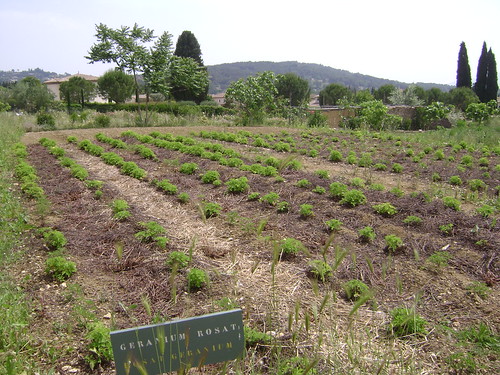Geranium, Soft and Pink
Pink Geranium, originally uploaded by fatminky.
But geranium, and bourbon geranium in particular, have an intensely sweet aspect to them that can smell almost confectionary. In Cabaret, a rosy floriental, the rose geranium plays a role greater than just extending the rose notes. I’ve taken advantage of this and paired Rose Geranium with Turkish rose otto and amber, surprisingly creating the illusion of coconut. To exaggerate this impression, I added some massoia bark, which has the fatty sweetness of roasted coconut. The result is strongly reminiscent of Rahat Loukum, immersed in rosewater and dusted with starch and coconut.
In the ylang ylang soliflore Coralle, Geranium Bourbon is merely in the background to round-off a tropical bouquet supported by the jam-like notes of davana (an herb from the Artemisia family that has notes of overripe berries and hints of Chambord liqueur). Geranium Bourbon is usually my least favourite choice because I find its full-bodied wine-like qualities overbearing at times. But in this context it was the right geranium to choose.
And more recently, for Mother’s Day, I’ve created Geranium Ritual Bath Salts that were meant to smell all feminine, pretty and grounding. I wanted it to conjure images of fresh laundry and babies (how motherly!) so I’ve also used hints of lavender for the fresh linen association, and Roman chamomile that creates a baby-powder accord with the other notes. Subtle amounts of myrrh and jasmine and the peru balsam oil as a fixative prevent it from smelling like yet another relaxing aromatherapy blend. Even though the formulation is for bath salts it will work beautifully as a real grown-up perfume.
The flowery and rosy components of geranium - linalol (which is also present in rosewood, ho wood and lavender) softens up geranium's otherwise bold character and of course when this aspect is accentuated, you will get a softer geranium. Also the rose alcohol (geraniol, citronellal, etc.) which are what gives geranium its rosy characteristics can be played softly, depending on the context, and avoiding the potpourri impression that is so easily to fall into when working with geranium. In Olivia Giacobetti's L'Ether, rose geranium is used so beautifully it has none of the harshness (it is not listed in the notes -Myrrh, Benzoin, Rosewood, Sandalwood, Saffron, Maple wood - but it is very present). The backdrop of myrrh and woods and the sweetness of benzoin make the geranium in L'Ether come across very mysterious, like the endless unfolding petals of a mythical eternally blooming rose.




